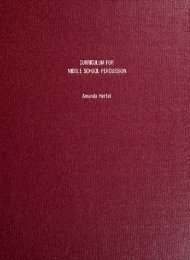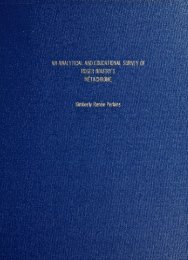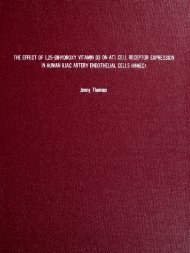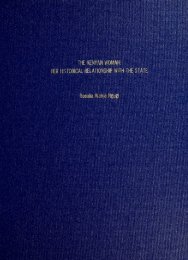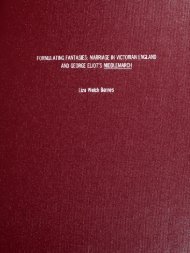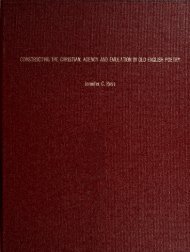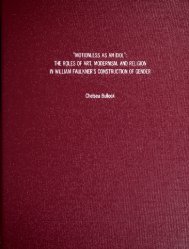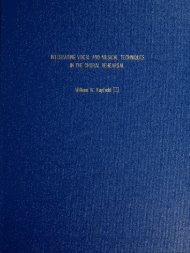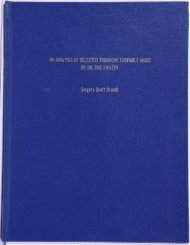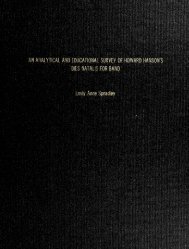The Effect of Aposematic Coloration on the Food Preference of ...
The Effect of Aposematic Coloration on the Food Preference of ...
The Effect of Aposematic Coloration on the Food Preference of ...
- No tags were found...
You also want an ePaper? Increase the reach of your titles
YUMPU automatically turns print PDFs into web optimized ePapers that Google loves.
,11resp<strong>on</strong>se from <strong>the</strong> bird.Trials were scored ei<strong>the</strong>r "red" or "white", depending <strong>on</strong> which bean ajay chose.A successful trial was determined based <strong>on</strong> a jay's removal <str<strong>on</strong>g>of</str<strong>on</strong>g> <strong>the</strong> bean from <strong>the</strong> hand,not ingesti<strong>on</strong> <str<strong>on</strong>g>of</str<strong>on</strong>g> <strong>the</strong> bean <strong>on</strong> site.Because scrub jays comm<strong>on</strong>ly cache <strong>the</strong>ir food, removal <str<strong>on</strong>g>of</str<strong>on</strong>g> <strong>the</strong>bean was sufficient to display a preference for <strong>the</strong> food source.<str<strong>on</strong>g>The</str<strong>on</strong>g> sec<strong>on</strong>d set <str<strong>on</strong>g>of</str<strong>on</strong>g> trials was c<strong>on</strong>ducted later in <strong>the</strong> summer, from July 28 to August 12002. This was during <strong>the</strong> end <str<strong>on</strong>g>of</str<strong>on</strong>g> <strong>the</strong> breeding seas<strong>on</strong> and after <strong>the</strong> main nesting period. <str<strong>on</strong>g>The</str<strong>on</strong>g>procedure for ga<strong>the</strong>ring data was altered due to a lack <str<strong>on</strong>g>of</str<strong>on</strong>g> resp<strong>on</strong>se to hand feeding by several <str<strong>on</strong>g>of</str<strong>on</strong>g><strong>the</strong> birds during <strong>the</strong> first trials.After evaluating <strong>the</strong> behavior <str<strong>on</strong>g>of</str<strong>on</strong>g> <strong>the</strong> birds during <strong>the</strong> May study, amore efficient testing procedure was developed using a clear plastic tray divided into fourseparate secti<strong>on</strong>s.<str<strong>on</strong>g>The</str<strong>on</strong>g> edges and dividers <str<strong>on</strong>g>of</str<strong>on</strong>g> <strong>the</strong> tray served as perches for <strong>the</strong> scrub jays duringfeeding. Also during this trial set, I decided to eliminate sites used previously that exposed <strong>the</strong>jays to frequent human interacti<strong>on</strong> and activity. It seemed that this exposure caused <strong>the</strong> jays todo <strong>on</strong>e <str<strong>on</strong>g>of</str<strong>on</strong>g> two things.In busy areas near streets, <strong>the</strong> birds would not interact at all, and in parkareas, <strong>the</strong> birds were too accustomed to being fed by humans to show cauti<strong>on</strong> <str<strong>on</strong>g>of</str<strong>on</strong>g> choice whenpresented a food source.<str<strong>on</strong>g>The</str<strong>on</strong>g> sites used during this porti<strong>on</strong> <str<strong>on</strong>g>of</str<strong>on</strong>g> <strong>the</strong> study were <strong>the</strong> Martin Countysite, used during <strong>the</strong> last two days <str<strong>on</strong>g>of</str<strong>on</strong>g> <strong>the</strong> first trials, and a new site at Juno Beach <str<strong>on</strong>g>of</str<strong>on</strong>g>f <str<strong>on</strong>g>of</str<strong>on</strong>g> USHighway 1 in Palm Beach County. This site was chosen based <strong>on</strong> informati<strong>on</strong> obtained from alocal resident.Juno Beach happened to be <strong>the</strong> site <str<strong>on</strong>g>of</str<strong>on</strong>g> a large scrub jay habitat restorati<strong>on</strong> project.Because access to <strong>the</strong> land was limited, I was able to locate <strong>on</strong>ly <strong>on</strong>e family unit <str<strong>on</strong>g>of</str<strong>on</strong>g> scrub jaysthat was comprised <str<strong>on</strong>g>of</str<strong>on</strong>g> an adult male, adult female, and four juveniles which were too young tosex.Sampling periods were during <strong>the</strong> same times as <strong>the</strong> first study - morning and lateafterno<strong>on</strong>.This time, <strong>the</strong> tray was placed <strong>on</strong> <strong>the</strong> ground, allowing <strong>the</strong> natural sandy substrate toserve as a background against which to place <strong>the</strong> beans.A red bean and white bean were placed



